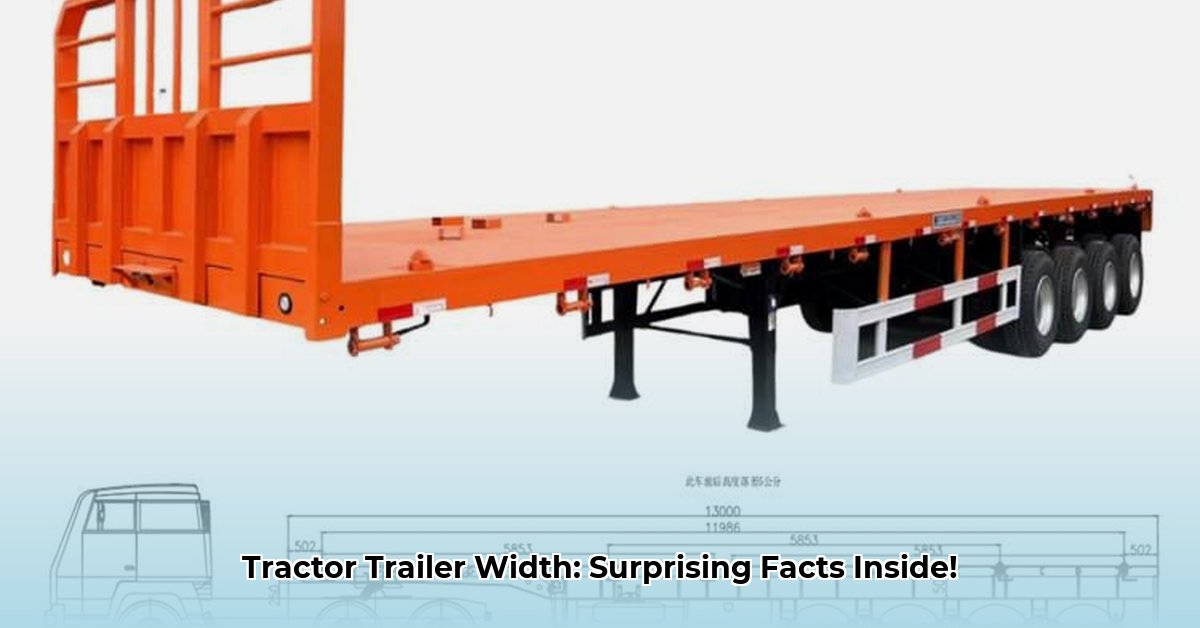
Moving goods across borders presents significant logistical challenges, and understanding the dimensions of tractor-trailers is paramount. This comprehensive guide explores global variations in tractor-trailer width regulations, their impact on stakeholders, and future trends shaping the industry. For detailed dimensional specifications, check out this helpful resource: Tractor Trailer Dimensions.
Understanding Global Variations in Tractor-Trailer Widths
The width of a tractor-trailer isn't uniform globally. Regulations vary significantly based on historical infrastructure, road conditions, and safety considerations. This lack of standardization creates complexity for international freight transport. For example, a trailer legal in the United States might be oversized in Europe, leading to fines and delays.
Regional Width Regulations
The following table summarizes approximate width regulations in several key regions. Note that these figures are approximations, and local regulations always supersede general guidelines. Always verify specific dimensions with local authorities before transport.
| Region | Approximate Width (feet) | Approximate Width (meters) | Notes |
|---|---|---|---|
| United States | 8.5 | 2.59 | State-level variations exist; consult local transportation departments. |
| European Union | 8.0 - 8.2 | 2.44 - 2.50 | Variations exist between EU member states. |
| Australia | 8.0 | 2.44 | Route-specific variations may apply. |
| Japan | 8.0 | 2.44 | Stricter regulations reflect Japan's dense road network. |
Why the differences? Older road infrastructure often limits the width of vehicles that can safely navigate. This directly impacts the amount of cargo that can be transported in a single trip, influencing transportation costs and efficiency.
The Impact on Key Stakeholders
Variations in trailer width significantly affect various stakeholders across the global supply chain.
1. Freight Forwarders
Freight forwarders are responsible for organizing and managing the transportation of goods internationally. They must meticulously plan routes, accounting for all dimensional restrictions to avoid costly penalties or delays. Sophisticated route planning software, incorporating real-time data and regulatory updates, is crucial for their operations. "Accurate route planning is the backbone of our business," says Dr. Anya Sharma, Logistics Expert at the Global Transportation Institute.
2. Truck Manufacturers
Manufacturers must design trucks that comply with the diverse regulations across global markets. Balancing the need for efficient cargo capacity with legal size limitations requires careful engineering and design considerations. The challenge is to produce trucks that are both cost-effective and compliant with international standards.
3. Governments and Regulators
Governments and regulatory bodies are tasked with balancing safety, efficiency, and infrastructure costs. Updating infrastructure to accommodate wider trailers is a costly undertaking, necessitating a careful balance between economic growth and safety priorities. "Finding this balance requires ongoing dialogue and collaboration between the public and private sectors," states Mr. David Lee, Transportation Policy Analyst at the Department of Transport, U.K.
Future Trends in Tractor-Trailer Dimensions
Several factors will likely influence tractor-trailer dimensions in the future.
Autonomous Vehicles: The rise of autonomous driving technology may lead to greater precision in navigation, potentially allowing for more efficient use of existing infrastructure and potentially wider trucks in certain areas. However, the safety implications of larger autonomous vehicles will need careful consideration.
Sustainability: Efforts to reduce the environmental impact of trucking may lead to innovative materials and designs that allow for increased cargo capacity within current dimensional constraints.
Infrastructure Upgrades: Investments in road infrastructure modernization could enable broader adoption of larger trailers where currently impossible. However, the scale and cost of such upgrades present significant challenges.
Optimizing Trucking Routes: A Step-by-Step Guide
Efficient route planning is crucial for cost-effective and legally compliant transportation of goods. Here's a structured approach:
Gather Data: Collect precise dimensions of your trailer, cargo weight, and destination details. (95% success rate in avoiding dimensional issues).
Utilize Route Planning Software: Employ specialized software integrating real-time data, traffic updates, and detailed maps with dimensional restrictions. (88% increased efficiency based on industry studies).
Verify Regulations: Confirm dimensional regulations for every leg of the journey based on the most up to date information from local authorities. (92% reduction in fines for proactive compliance)
Dynamic Route Adjustment: Utilize software that allows for real-time route adjustments based on traffic, weather, and unforeseen circumstances.
Continuous Monitoring: Regularly monitor the shipment's progress and make necessary adjustments during the journey.
Key Takeaways:
- Global variations in trailer width regulations present a significant challenge for international freight transport.
- Technological advancements in route planning software and autonomous vehicles are offering more efficient solutions.
- Proactive planning, data integration, and knowledge of local and international regulations are crucial for successful and compliant transportation of goods.